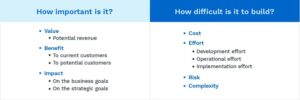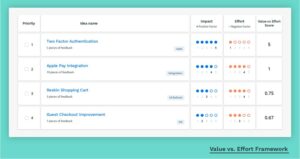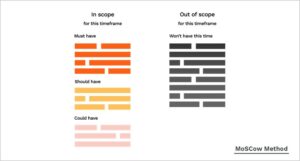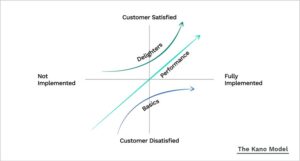3 Prioritisation Techniques for Arts Marketeers
In today’s dynamic landscape, where arts marketeers often find themselves grappling with limited resources and an ever-expanding array of strategic choices, the role of prioritisation tools has become increasingly vital. Among these tools, frameworks such as Value vs. Effort, The Kano Model, and the MoSCoW method stand out as invaluable assets for guiding marketeers through the complex terrain of decision-making.
By providing structured approaches to assess and rank your proposed activities, initiatives, tasks or goals, these methods offer a systematic and data-driven way for marketeers to allocate their resources effectively. These tools can empower arts and cultural organisations to optimise their strategies, enhance customer satisfaction, and achieve business objectives in an efficient manner. Now, let’s take a closer look at how to use them and some of the pros and cons.
1. Value vs. Effort
This simple approach to prioritisation involves taking your list of goals, tasks, or activities and quantifying them using value and effort scores.
With this method, it’s important to keep in mind that the final scores are just an estimation. A lot of guesswork and opinions are involved in the process of quantifying them. The big question prioritisation aims to answer is: “Will this activity or initiative push our goals and metrics forward if we adopt it? Or can we feasibly execute the task with the resources we have?”

Scoring methods like value vs. effort give marketing teams a quick and easy way to visualise a set of quantified priorities.
This method of prioritisation can stimulate healthy discussions among managers and teams on what they believe the most important values are and/or how to fix them. Here’s what a value vs. effort scorecard looks like:

Pros of using value vs. effort framework
- What constitutes value or effort is flexible. For some organisations, effort could just mean how challenging a task is to execute, in others it could be the cost of implementation.
- It is a good technique for alignment. By numerically scoring activities and initiatives, marketing teams can collectively agree on which activities have more weight than others. It leaves guesswork and assumptions out of the discussion about what to prioritise and what to descope.
- In organisations where resources are extremely limited, something as simple as a value vs. effort analysis allows teams to focus only on the things that will have the biggest impact on their overarching business goals.
- It is easy to use because it does not involve any complex formulas or models. All it requires is an agreed-upon numerical value that gets added into one overall total number.
Cons of using value vs. effort framework
- Like all prioritisation exercises, it’s a game of estimation and guessing. This leaves a lot of room for bias at the hands of the people doing the estimating. The final score for each activity might be too inflated, or not accurate enough.
- When it’s time to vote on how high or low the value/effort scores should be, the disagreements can take a while to resolve.
- It can be hard to use with large teams or organisations that collaborate between different departments.
2. The MoSCoW Method
The MoSCoW method allows marketeers to figure out what matters the most to your customers by classifying activities and initiatives into four priority categories. MoSCoW stands for Must-Have, Should-Have, Could-Have, and Won’t-Have requirements.
- Must-Have: These are the requirements that have to be present for your marketing plans to be functional at all. They’re non-negotiable and essential. If one of these essential parts isn’t present, work cannot start, therefore making it the most time-critical of all the buckets.
Example: “Customers MUST be able to access services on the website”
- Should-Have: These requirements or activities are important to deliver, but they’re not time sensitive.
Example: “Customers SHOULD have the option to buy tickets direct from our website”
- Could-Have: This is an activity or initiative that’s neither essential nor important to deliver within a timeframe. They’re bonuses that would improve customer satisfaction, but don’t have a great impact if they’re left out.
Example: “Customers COULD save a wish list of upcoming events they are interested in”
- Won’t-Have: These are the least critical requirements (and the first to go when there are resource or capacity constraints). These are activities or initiatives to be considered for future plans or objectives.
The MoSCoW model is dynamic and allows room for evolving priorities. So, an activity that was considered a “Won’t-Have” can one day become a “Must-Have” depending on the type of project or program.

Pros of using the MoSCoW Method
- It is good for involving team members without a technical background in the prioritisation process.
- It is a quick, easy and intuitive way of communicating priorities to the wider team.
- It allows you to think about resource allocation when you classify your marketing activities and initiatives into each bucket.
Cons of using the MoSCoW Method
- It is tempting for teams and stakeholders to overestimate the number of Must-Have requirements.
- It is an exercise in formulating a marketing plan or roadmap more than a prioritisation method.
3. Kano Model
The Kano model plots two sets of parameters along a horizontal and a vertical axis. On the horizontal axis, you have the degree that an activity or initiative meets your audience’s needs. These values can be classified into three buckets:
- Must-haves or basic activities: If you don’t have these activities, your customers won’t even consider your offering as an answer to their wants, needs or desires.
- Performance activities: The more you invest in these, the higher the level of customer satisfaction will be.
- Delighters or excitement activities: These initiatives are pleasant surprises that the customers don’t expect, but that once provided, create a delighted response.
On the vertical axis, you have the level of customer satisfaction (the satisfaction values). This shows how satisfaction increases as activities or initiatives are implemented and achieved, from customer needs not being met on the left, all the way to the needs being fully met on the right (the implementation values).
The way you get this customer insight is by developing a Kano questionnaire where you ask your customers how they’d feel with or without any given offering or planned initiative.
The core idea of the Kano model is that the more time you spend investing resources (time, money, effort) to create, innovate and improve the activities or initiatives in each of the three buckets, the higher the level of customer satisfaction will be. The caveat here, is that customer satisfaction can plateau when all of their needs are met, so putting time and energy into increasing satisfaction further is actually wasted effort. Identifying the point at which your customers are truly satisfied can be a difficult value to obtain and measure.

Pros of using the Kano Model
- The Kano model questionnaire can teach teams not to overestimate excitement and to stop underestimating must-haves.
- By talking to real users, you can get an external perspective, one that is not influenced by you or your team’s internal biases or preferences.
- It can help marketing teams make better predictions for the success of proposed activities or initiatives and your audience’s expectations for them.
Cons of using the Kano Model
- The Kano questionnaire can be time-consuming. To get a fair representation of your audience, you need to carry a number of surveys that are proportionate to the number of customers you have.
- Your customers might not fully understand the initiatives you’re surveying them about.
4. What’s next?
The Digital Culture Network is here to support you or your organisation. Our Tech Champions can provide free 1-2-1 support to all creative and cultural individuals and organisations who are in receipt of, or eligible for, Arts Council England funding. If you need help or would like to chat with us about any of the advice we have covered above, please get in touch. Sign up for our newsletter below and follow us on Twitter @ace_dcn and LinkedIn for the latest updates.











